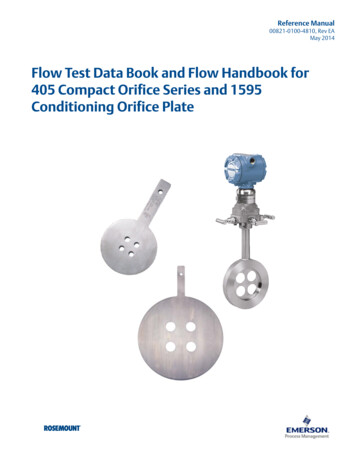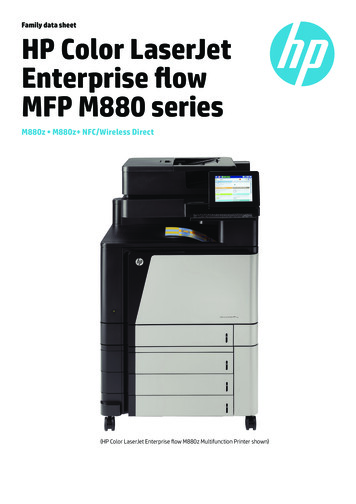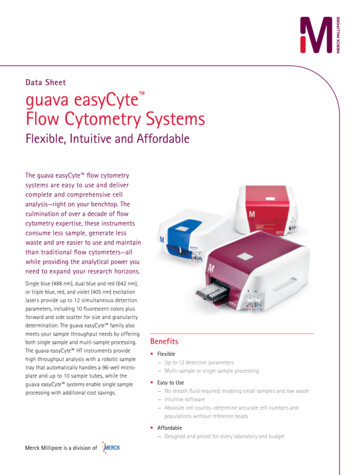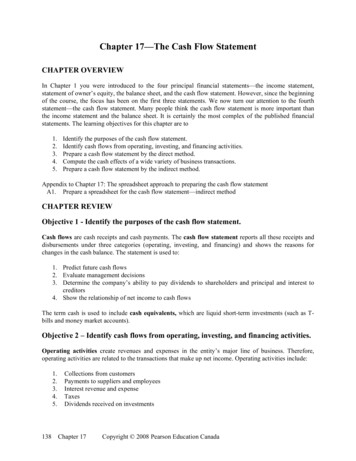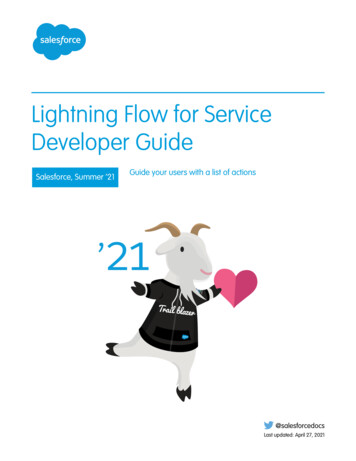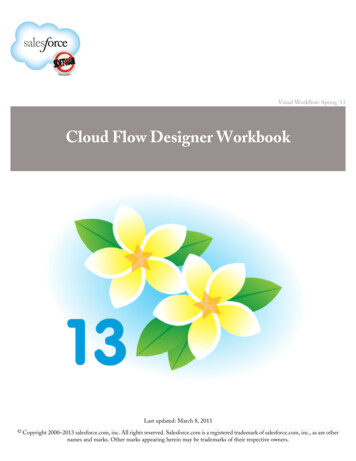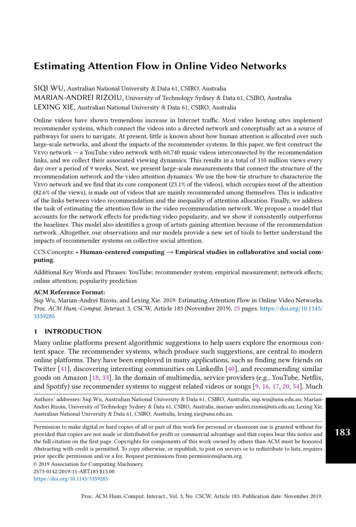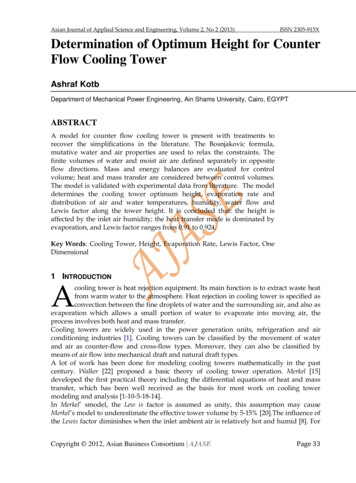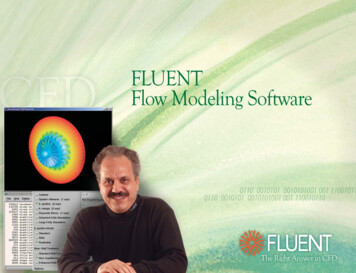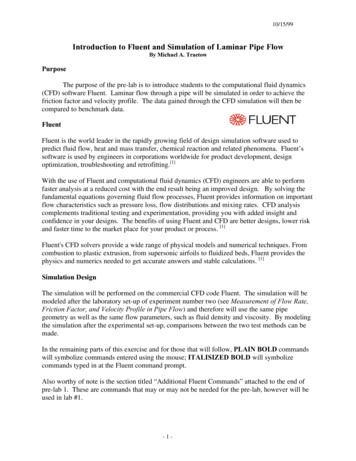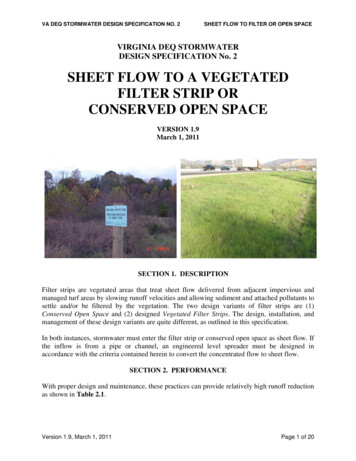
Transcription
VA DEQ STORMWATER DESIGN SPECIFICATION NO. 2SHEET FLOW TO FILTER OR OPEN SPACEVIRGINIA DEQ STORMWATERDESIGN SPECIFICATION No. 2SHEET FLOW TO A VEGETATEDFILTER STRIP ORCONSERVED OPEN SPACEVERSION 1.9March 1, 2011SECTION 1. DESCRIPTIONFilter strips are vegetated areas that treat sheet flow delivered from adjacent impervious andmanaged turf areas by slowing runoff velocities and allowing sediment and attached pollutants tosettle and/or be filtered by the vegetation. The two design variants of filter strips are (1)Conserved Open Space and (2) designed Vegetated Filter Strips. The design, installation, andmanagement of these design variants are quite different, as outlined in this specification.In both instances, stormwater must enter the filter strip or conserved open space as sheet flow. Ifthe inflow is from a pipe or channel, an engineered level spreader must be designed inaccordance with the criteria contained herein to convert the concentrated flow to sheet flow.SECTION 2. PERFORMANCEWith proper design and maintenance, these practices can provide relatively high runoff reductionas shown in Table 2.1.Version 1.9, March 1, 2011Page 1 of 20
VA DEQ STORMWATER DESIGN SPECIFICATION NO. 2SHEET FLOW TO FILTER OR OPEN SPACETable 2.1: Summary of Stormwater Functions Provided by Filter StripsConservation AreaStormwater FunctionHSG SoilsA and BHSG SoilsC and DVegetated Filter StripHSG SoilsHSG Soils4B , C andAD2Annual Runoff Vol. Reduction (RR)Total Phosphorus (TP) EMC5Reduction by BMP TreatmentProcessTotal Phosphorus (TP) Mass LoadRemovalTotal Nitrogen (TN) EMC Reductionby BMP Treatment ProcessTotal Nitrogen (TN) Mass LoadRemovalChannel Protection andFlood MitigationAssume no CA inConservation Area75%50%No CAWith CA250%050%50%075%350%075%150%050%50%50%Partial. Designers can use the RRM spreadsheet toadjust curve number for each design storm for thecontributing drainage area; anddesigners can account for a lengthened Time-ofConcentration flow path in computing peak discharge.1CWP and CSN (2008); CWP (2007)CA Compost Amended Soils (see Design Specification No. 4)3Compost amendments are generally not applicable for undisturbed A soils, although it may beadvisable to incorporate them on mass-graded A or B soils and/or filter strips on B soils, in orderto maintain runoff reduction rates.4The plan approving authority may waive the requirement for compost amended soils for filterstrips on B soils under certain conditions (see Section 6.2 below)5There is insufficient monitoring data to assign a nutrient removal rate for filter strips at this time.2SECTION 3. DESIGN TABLEConserved Open Space and Vegetated Filter Strips do not have two levels of design. Instead,each must meet the appropriate minimum criteria outlined in Table 2.2 (next page) and Section6 (below) to qualify for the indicated level of runoff reduction. In addition, designers mustconduct a site reconnaissance prior to design to confirm topography and soil conditions.SECTION 4. TYPICAL DETAILSFigure 1 shows a typical approach for sheetflow to a Conserved Open Space (Cappiella et al.,2006). Figures 2 and 3 provide standard details for an engineered level spreader developed byNorth Carolina State University (Hathaway and Hunt, 2006). An alternative design for an“energy dissipater” can be found in Henrico County’s Environmental Program Manual (Chapter9, Minimum Design Standard 9.01) at: http://www.co.henrico.va.us/works/eesd/Version 1.9, March 1, 2011Page 2 of 20
VA DEQ STORMWATER DESIGN SPECIFICATION NO. 2SHEET FLOW TO FILTER OR OPEN SPACETable 2.2. Filter Strip Design CriteriaDesign IssueSoil and VegetativeCover(Sections 6.1 and6.2)Overall Slope andWidth (perpendicularto the flow)(Section 5)Sheet Flow(Section 5)Concentrated Flow(Section 6.3)Construction Stage(Section 8)Typical Applications(Section 5)CompostAmendments(Section 6.1)Boundary Spreader(Section 6.3)Conserved Open SpaceVegetated Filter StripAmended soils and dense turfUndisturbed soils and nativecover or landscaped withvegetationherbaceous cover, shrubs, andtrees11% to 4% Slope – Minimum 350.5% to 3% Slope – Minimum 35 ftft. widthwidth4% to 6% Slope – Minimum 50 ft.3% to 6% Slope – Minimum 50 ftwidthwidth6% to 8% Slope – Minimum 65 ft.The first 10 ft. of filter must be 2% or width2less in all casesThe first 10 ft. of filter must be 2%or less in all casesMaximum flow length of 150 ft. from adjacent pervious areas;Maximum flow length of 75 ft. from adjacent impervious areas6Length of ELS Lip 13 lin. ft. pereach 1 cfs of inflow if area has 90%36CoverLength of ELS Lip 13 lin.ft. perLength 40 lin. ft. per 1 cfs foreach 1 cfs of inflow (13 lin.ft. min;4130 lni.ft. max.)forested or re-forested Areas6(ELS length 13 lin.ft. min; 130lin.ft. max.)Located outside the limits ofPrevent soil compaction by heavydisturbance and protected by ESCequipmentcontrolsTreat small areas of IC (e.g.,Adjacent to stream or wetland buffer 5,000 sf) and/or turf-intensive landor forest conservation areauses (sports fields, golf courses)close to sourceNoYes (B, C, and D soils)56GD at top of filter6PB at toe of filter1A minimum of 1% is recommended to ensure positive drainage.2For Conservation Areas with a varying slope, a pro-rated length may be computed only if thefirst 10 ft. is 2% or less.3Vegetative Cover is described in Section 6.2.4Where the Conserved Open Space is a mixture of native grasses, herbaceous cover and forest6(or re-forested area), the length of the ELS Lip can be established by computing a weightedaverage of the lengths required for each vegetation type. Refer to Section 6.3 for design criteria5The plan approving authority may waive the requirement for compost amended soils for filterstrips on B soils under certain conditions (see Section 6.1).6ELS Engineered Level Spreader; GD Gravel Diaphragm; PB Permeable Berm.Version 1.9, March 1, 20116GD at top of filterPage 3 of 20
VA DEQ STORMWATER DESIGN SPECIFICATION NO. 2SHEET FLOW TO FILTER OR OPEN SPACEFigure 2.1. Typical Sheetflow to Conserved Open SpaceFigure 2.2. Level Spreader Forebay (Hathaway and Hunt 2006)Version 1.9, March 1, 2011Page 4 of 20
VA DEQ STORMWATER DESIGN SPECIFICATION NO. 2SHEET FLOW TO FILTER OR OPEN SPACEFigure 2.3: Plan and Cross Section of Engineered Level Spreader (ELS)(Hathaway 2006)Version 1.9, March 1, 2011Page 5 of 20
VA DEQ STORMWATER DESIGN SPECIFICATION NO. 2SHEET FLOW TO FILTER OR OPEN SPACEFigure 2.4A: Section - Level Spreader with Rigid LipVersion 1.9, March 1, 2011Page 6 of 20
VA DEQ STORMWATER DESIGN SPECIFICATION NO. 2SHEET FLOW TO FILTER OR OPEN SPACEFigure 2.4B: Section - Alternative Level Spreader with Vegetated LipVersion 1.9, March 1, 2011Page 7 of 20
VA DEQ STORMWATER DESIGN SPECIFICATION NO. 2SHEET FLOW TO FILTER OR OPEN SPACESHEET FLOW FROMIMPERVIOUS OR TURFFigure 2.5 – Gravel Diaphragm – Sheet Flow Pre-treatmentFigure 2.6: Level Spreader: Pipe or Channel Flow to Filter Strip or Preserved Open SpaceVersion 1.9, March 1, 2011Page 8 of 20
VA DEQ STORMWATER DESIGN SPECIFICATION NO. 2SHEET FLOW TO FILTER OR OPEN SPACEFigure 2.7: Simple Disconnection to downstream Preserved Open Spaceor Vegetated Filter StripVersion 1.9, March 1, 2011Page 9 of 20
VA DEQ STORMWATER DESIGN SPECIFICATION NO. 2SHEET FLOW TO FILTER OR OPEN SPACESECTION 5. PHYSICAL FEASIBILITY & DESIGN APPLICATIONS5.1Conserved Open SpaceThe most common design applications of Conserved Open Space are on sites that arehydrologically connected to a protected stream buffer, wetland buffer, floodplain, forestconservation area, or other protected lands. Conserved open space is an ideal component of the"outer zone" of a stream buffer, such as a Resource Protection Area (as is required in some partsof the state), which normally receives runoff as sheetflow. Care should be taken to locate allenergy dissipaters or flow spreading devices outside of the protected area.Designers may apply a runoff reduction credit to any impervious or managed turf cover that ishydrologically connected and effectively treated by a protected Conserved Open Space thatmeets the following eligibility criteria: The goal of establishing Conserved Open Space is to protect a vegetated area contiguous to areceiving system, such as a stream or natural channel, for treating stormwater runoff.Establishing isolated Conserved Open Space pockets on a development site may not achievethis goal unless they effectively serve to connect the surface runoff to the receiving system.Therefore, a locality may choose to establish goals for minimum acreage to be conserved (interms of total acreage or percentage of the total project site), and the physical location(adjacent to a stream, or other criteria) in order for the cumulative conserved open space toqualify for the RRM credit.No major disturbance may occur within the conserved open space during or afterconstruction (i.e., no clearing or grading is allowed except temporary disturbances associatedwith incidental utility construction, restoration operations, or management of nuisancevegetation). The Conserved Open Space area shall not be stripped of topsoil. Some lightgrading may be needed at the boundary using tracked vehicles to prevent compaction.The limits of disturbance should be clearly shown on all construction drawings and protectedby acceptable signage and erosion control measures.A long term vegetation management plan must be prepared to maintain the Conserved OpenSpace in a natural vegetative condition. Generally, Conserved Open Space managementplans do not encourage or even allow any active management. However, a specific planshould be developed to manage the unintended consequences of passive recreation, controlinvasive species, provide for tree and understory maintenance, etc. Managed turf is notconsidered an acceptable form of vegetative management, and only the passive recreationareas of dedicated parkland are eligible for the practice (e.g., the actively used portions ofball fields and golf courses are not eligible), although conservation areas can be idealtreatment practices at the edges of turf-intensive land uses.The Conserved Open Space must be protected by a perpetual easement or deed restrictionthat assigns the responsible party to ensure that no future development, disturbance, orclearing may occur within the area.The practice does not apply to jurisdictional wetlands that are sensitive to increased inputs ofstormwater runoff (e.g., bogs and fens).Version 1.9, March 1, 2011Page 10 of 20
VA DEQ STORMWATER DESIGN SPECIFICATION NO. 25.2SHEET FLOW TO FILTER OR OPEN SPACEVegetated Filter StripsVegetated Filter Strips are best suited to treat runoff from small segments of impervious cover(usually less than 5,000 sq. ft. ) adjacent to road shoulders, small parking lots and rooftops.Vegetated Filter Strips may also be used as pretreatment for another stormwater practice such asa dry swale, bioretention, or infiltration areas. If sufficient pervious area is available at the site,larger areas of impervious cover can be treated by vegetated filter strips, using an engineeredlevel spreader to recreate sheet flow. Vegetated Filter Strips are also well suited to treat runofffrom turf-intensive land uses, such as the managed turf areas of sports fields, golf courses, andparkland.Conserved Open Space and Vegetated Filter Strips can be used in a variety of situations;however there are several constraints to their use: Filter Slopes and Widths. Maximum slopes for Conserved Open Space and Vegetated FilterStrips are 6% and 8% respectively, in order to maintain sheet flow through the practice. Inaddition, the overall contributing drainage area must likewise be relatively flat to ensuresheet flow draining into the filter. Where this is not possible, alternative measures, such as anengineered level spreader, can be used. Minimum widths (flow path) for Conserved OpenSpace and Vegetated Filter Strips are dependent on slope, as specified in Table 2.2 above. Soils. Vegetated Filter Strips are appropriate for all soil types, except fill soils. The runoffreduction rate, however, is dependent on the underlying Hydrologic Soil Groups (see Table2.1 above) and whether soils receive compost amendments. Contributing Flow Path to Filter. Vegetated Filter Strips are used to treat very smalldrainage areas of a few acres or less. The limiting design factor is the length of flow directedto the filter. As a rule, flow tends to concentrate after 75 feet of flow length for impervioussurfaces, and 150 feet for pervious surfaces (Claytor, 1996). When flow concentrates, itmoves too rapidly to be effectively treated by a Vegetated Filter Strip, unless an engineeredlevel spreader is used. When the existing flow at a site is concentrated, a vegetated swaleshould be used instead of a Vegetated Filter Strip (Lantin and Barrett, 2005). Hotspot Land Uses. Vegetated Filter Strips should not receive hotspot runoff, since theinfiltrated runoff could cause groundwater contamination. Turf-Intensive Land Uses. Both Conserved Open Space and Vegetated Filter Strips areappropriate to treat managed turf and the actively-used areas of sports fields, golf courses,parkland, and other turf-intensive land uses. Proximity of Underground Utilities. Underground pipes and conduits that cross theVegetated Filter Strip are acceptable.Version 1.9, March 1, 2011Page 11 of 20
VA DEQ STORMWATER DESIGN SPECIFICATION NO. 2SHEET FLOW TO FILTER OR OPEN SPACESECTION 6. DESIGN CRITERIA6.1. Compost Soil AmendmentsCompost soil amendments will enhance the runoff reduction capability of a vegetated filter stripwhen located on hydrologic soil groups B, C, and D, subject to the following designrequirements: The compost amendments should extend over the full length and width of the filter strip.The amount of approved compost material and the depth to which it must be incorporated isoutlined in Stormwater Design Specification No. 4.The amended area will be raked to achieve the most level slope possible without using heavyconstruction equipment, and it will be stabilized rapidly with perennial grass and/orherbaceous species.If slopes exceed 3%, a protective biodegradable fabric or matting (e.g., EC-2) should beinstalled to stabilize the site prior to runoff discharge.Compost amendments should not be incorporated until the gravel diaphragm and/orengineered level spreader are installed (see Section 6.3).The local plan approval authority may waive the requirement for compost amendments onHSG-B soils in order to receive credit as a filter strip if (1) the designer can provideverification of the adequacy of the on-site soil type, texture, and profile to function as a filterstrip, and (2) the area designated for the filter strip will not be disturbed during construction.6.2. Planting and Vegetation ManagementConserved Open Space . No grading or clearing of native vegetation is allowed within theConserved Open Space. An invasive species management plan should be developed andapproved by the local plan approval authority.Reforested Conserved Open Space. At some sites, the proposed stream buffer or ConservedOpen Space may be in turf or meadow cover, or overrun with invasive plants and vines. In thesesituations, a landscape architect or horticulturalist should prepare a reforestation or restorationplan for the Conserved Open Space. The entire area can be planted with native trees and shrubsor planted to achieve a gradual transition from turf to meadow to shrub and forest. Trees andshrubs with deep rooting capabilities are recommended for planting to maximize soil infiltrationcapacity (PWD, 2007). Over-plant with seedlings for fast establishment and to account formortality. Plant larger stock at desired spacing intervals (25 to 40 feet for large trees) usingrandom spacing (Cappiella et al., 2006). Plant ground cover or a herbaceous layer to ensure rapidvegetative cover of the surface area.Vegetated Filter Strips. Vegetated Filter Strips should be planted at such a density to achieve a90% grass/herbaceous cover after the second growing season. Filter strips should be seeded, notsodded. Seeding establishes deeper roots, and sod may have muck soil that is not conducive toinfiltration (Wisconsin DNR, 2007). The filter strip vegetation may consist of turf grasses,meadow grasses, other herbaceous plants, shrubs, and trees, as long as the primary goal of atleast 90% coverage with grasses and/or other herbaceous plants is achieved. Designers shouldVersion 1.9, March 1, 2011Page 12 of 20
VA DEQ STORMWATER DESIGN SPECIFICATION NO. 2SHEET FLOW TO FILTER OR OPEN SPACEchoose vegetation that stabilizes the soil and is salt tolerant. Vegetation at the toe of the filter,where temporary ponding may occur behind the permeable berm, should be able to withstandboth wet and dry periods. The planting areas can be divided into zones to account for differencesin inundation and slope.6.3. Diaphragms, Berms and Level SpreadersGravel Diaphragms: A pea gravel diaphragm at the top of the slope is required for bothConserved Open Space and Vegetated Filter Strips that receive sheetflow. The pea graveldiaphragm is created by excavating a 2-foot wide and 1-foot deep trench that runs on the samecontour at the top of the filter strip. The diaphragm serves two purposes. First, it acts as apretreatment device, settling out sediment particles before they reach the practice. Second, it actsas a level spreader, maintaining sheet flow as runoff flows over the Filter Strip. Refer to Figure2.5. The flow should travel over the impervious area and to the practice as sheet flow and thendrop at least 3 inches onto the gravel diaphragm. The drop helps to prevent runoff fromrunning laterally along the pavement edge, where grit and debris tend to build up (thusallowing by-pass of the Filter Strip).A layer of filter fabric should be placed between the gravel and the underlying soil trench.If the contributing drainage area is steep (6% slope or greater), then larger stone (clean bankrun gravel that meets VDOT #57 grade) should be used in the diaphragm.If the contributing drainage area is solely turf (e.g., sports field), then the gravel diaphragmmay be eliminated.Permeable Berm: Vegetated Filter Strips should be designed with a permeable berm at the toe ofthe Filter Strip to create a shallow ponding area. Runoff ponds behind the berm and graduallyflows through outlet pipes in the berm or through a gravel lens in the berm with a perforatedpipe. During larger storms, runoff may overtop the berm (Cappiella et al., 2006). The permeableberm should have the following properties: A wide and shallow trench, 6 to 12 inches deep, should be excavated at the upstream toe ofthe berm, parallel with the contours.Media for the berm should consist of 40% excavated soil, 40% sand, and 20% pea gravel.The berm 6 to 12 inches high should be located downgradient of the excavated depressionand should have gentle side slopes to promote easy mowing (Cappiella et al., 2006).Stone may be needed to armor the top of berm to handle extreme storm events.A permeable berm is not needed when vegetated filter strips are used as pretreatment toanother stormwater practice.Engineered Level Spreaders. The design of engineered level spreaders should conform to thefollowing design criteria based on recommendations of Hathaway and Hunt (2006), or a locallyapproved standard that meets the intent of these criteria, in order to ensure non-erosive sheetflow into the vegetated buffer area. Figure 2.3 above represents a configuration that includes abypass structure that diverts the design storm to the level spreader, and bypasses the larger stormevents around the Conserved Open Space or Vegetated Filter Strip through an improved channel.Version 1.9, March 1, 2011Page 13 of 20
VA DEQ STORMWATER DESIGN SPECIFICATION NO. 2SHEET FLOW TO FILTER OR OPEN SPACEAn alternative approach is that utilized by Henrico County, where pipe or channels discharge atthe landward edge o
VA DEQ STORMWATER DESIGN SPECIFICATION NO. 2 SHEET FLOW TO FILTER OR OPEN SPACE Version 1.9, March 1, 2011 Page 2 of 20 Table 2.1: Summary of Stormwater Functions Provided by Filter Strips 1 Stormwater Function Conservation Area Vegetated Filter Strip HSG Soils A and B HSG Soils C and D HSG Soils A HSG Soils B 4, C and D Assume no CA 2 in

